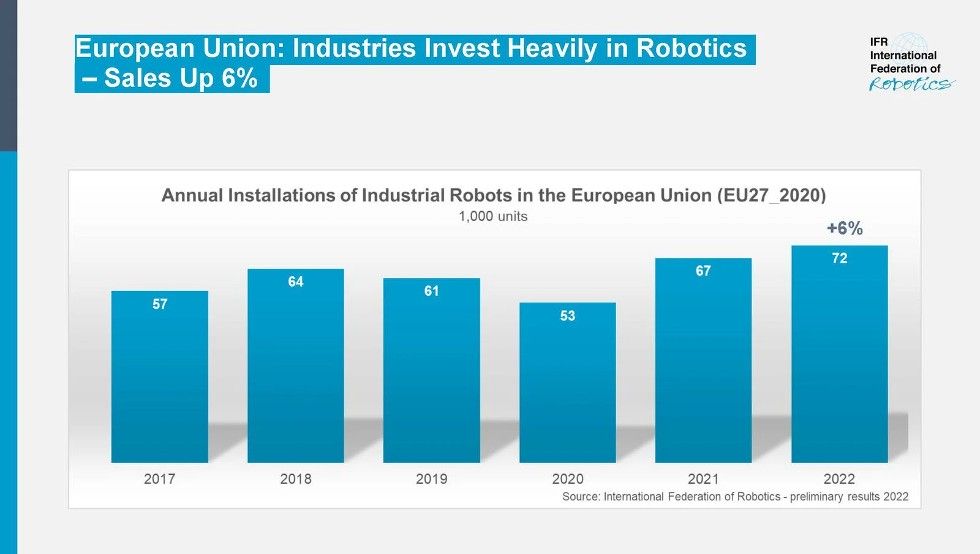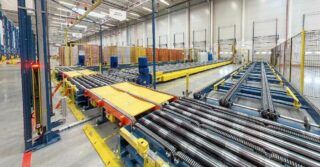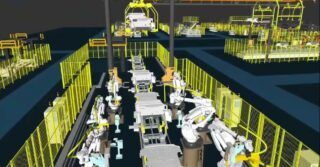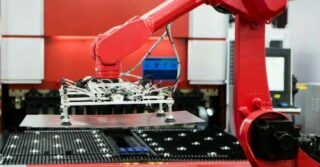Industrial robots in Europe are on the rise: The European Union´s (EU) 27 member states installed almost 72,000 units in 2022 – up 6% year-on-year. These are PRELIMINARY results, presented in the report by the International Federation of Robotics (IFR).
“The top five adopting countries within the EU are Germany, Italy, France, Spain and Poland,” says Marina Bill, President of the International Federation of Robotics (IFR). “They account for about 70% of all industrial robots installed within the EU in 2022.”
Germany is by far the largest robot market in Europe: about 26,000 units (+3%) were installed in 2022. This was a share of 37% of total EU installations. Worldwide, the country had the fourth highest robot density, following Japan, Singapore, and the Republic of Korea.
The automotive industry is traditionally the main customer of industrial robots in Germany. 27% of the newly deployed robots were installed in this industry in 2022. This was 7,100 units, down 22% from the previous year – a cyclical investment behavior well known in this segment. In the general industry, the main customer was the metal industry that installed 4,200 units (+20%) in 2022. This is above the pre-pandemic level that fluctuated around 3,500 units per year with a peak level of 3,700 units in 2019. Installations in the plastic and chemical products industry were back at a pre-pandemic level – up by 7% to 2,200 units in 2022.
Italy is the second largest robot market in Europe after Germany. An all-time high of almost 12,000 units (+10%) were installed in 2022. This was a share of 16% of total EU installations.
The country has a strong metal and machinery industry: Sales reached 3,700 units – in 2022 – up 18% compared to the previous year. Robot sales in the plastic and chemical products industry grew by 42% with 1,400 units installed. And the country also has a powerful food & beverages industry. Installations went up by 9% reaching 1,400 units in 2022. Demand from the automotive industry was down by 22% to 900 units. This segment is dominated by the Stellantis Group that resulted from the merger of FIAT-Chrysler and PSA of France.
The robot market in France ranked third in Europe in 2022. Annual installations went up by 15% with a total number of 7,400 units. This is less than a third the number of neighboring Germany. The main customer is the metal industry with a market share of 22%. The segment installed 1,600 units – up 23%. The automotive industry grew by 19% and reached 1,600 units. This represents a market share of 21%. The French government’s €100bn stimulus package for investment in smart factory equipment that came into effect mid-2021 will create new demand for industrial robots in the next few years.
Annual installations in Spain grew by 12% with a total number of 3,800 units. Robot installations are traditionally determined by the automotive industry. According to the International Organization of Motor Vehicle Manufacturers (OICA), Spain is the second largest producer of cars in Europe following Germany. The car industry in Spain installed 900 units – up 5%. Sales in the metal industry grew by 20% and reached 900 units. Automotive and the metal industry accounted for almost 50% of the robot installations in 2022.

Robot installations in Poland had been on a strong upward trajectory for nine years.
Annual installations reached a total number of 3,100 units in 2022 – the second-best result after the new peak level of 3,500 units in 2021. Demand from the metal and machinery industry was up by 17% to 600 units in 2022. The automotive industry displayed a cyclical demand with 500 units installed – down 37%. The war in neighboring Ukraine dampened the manufacturing industries. But investments in digitalization and automation technologies will benefit from a total of €160 bn in EU investment support between 2021 and 2027.
Robot installations in European countries including non-EU member states reached a total of 84,000 units – up 3% in 2022.


![Industrial robots in Europe are on the rise: Sales Up 6% [IFR REPORT] Industrial robots in Europe are on the rise: Sales Up 6% [IFR REPORT]](https://industryinsider.eu/wp-content/uploads/xindustrial-robotos-980x512.jpg.pagespeed.ic.6GF7xOmtHQ.jpg)



![Forecasts, Opportunities, and Challenges for the Polish Industry in 2024 [ANALYSIS] Forecasts, Opportunities, and Challenges for the Polish Industry in 2024 [ANALYSIS]](https://industryinsider.eu/wp-content/uploads/xIndustry-40-320x167.jpg.pagespeed.ic.o8zijDQlIJ.jpg)
![The importance of artificial intelligence in transport and automotive industry is growing [REPORT] The importance of artificial intelligence in transport and automotive industry is growing [REPORT]](https://industryinsider.eu/wp-content/uploads/xcity-320x167.jpeg.pagespeed.ic.xFkQdk7qXO.jpg)
